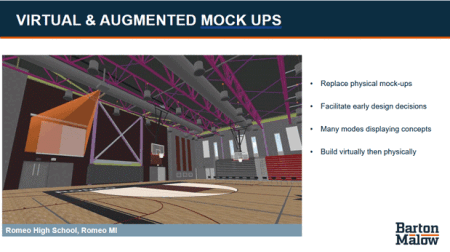Four leading development and construction companies participating in the ULI Spring Meeting Webinar Series showcased how innovation in design and construction is creating significant opportunities for reducing environmental impact, with significant savings that can offset any added cost.
ULI Greenprint members from Barton Malow, citizenM, Skanska USA, and Lendlease Americas highlighted how they are mobilizing new technologies, new materials, and new collaborations across supply chains to reduce buildings’ carbon footprints before occupancy even begins.
Barton Malow, a technology-forward construction company, believes that technology “should be used to make us better builders,” according to Ted Jennings, senior virtual design and construction manager. “Technology should help us with cost savings, schedule certainty, and sustainability.” To that end, Barton Malow uses virtual and augmented reality technology to create virtual mockups, facilitating easy design changes prior to construction and allowing instant tests of design options, such as materials for floors, walls, or facades.
This easy testing capability minimizes the need for change orders, speeding up the construction process. It has a sustainability element as well: “Virtual reality is a key tool for how we evaluate materials as part of the sustainability effort,” said Jennings.
A global hotel chain, citizenM noted that the modular approach they adopted to avoid the frequent conflict and distrust they observed in the traditional construction process resulted in unexpected sustainability benefits. “When we started, we didn’t take this approach because we thought it was so great from a sustainability point of view,” noted Menno Hilberts, U.S. project director. “But when we started looking at it more holistically and peeling back the layers of the onion, we found that it has quite significant benefits for sustainability,” especially over a longer building lifespan of 60 years or more.
By using a modular construction process in which all guest rooms–80 percent of the building–are prefabricated off site and then fit together on site, citizenM saw faster construction times, reduced waste and labor on site, increased construction quality and energy performance during building operations, and increased ease and decreased carbon emissions during demolition.
This technique streamlines their construction process considerably, reducing onsite construction time down to just a couple of weeks, while also slashing their hotels’ carbon emissions. By their estimates, one citizenM hotel emits nearly 70 percent less carbon than a traditional hotel when considering the entire lifecycle of the building (from construction to demolition).
Skanska USA has also seen the significant reductions possible when they started examining the carbon embedded in their building materials during material production, transport, and installation (known as “embodied” carbon). According to sustainability director Sarah King, the company has a “longstanding and strong commitment to sustainability” and aims to go carbon neutral by 2045, meaning they will cancel out whatever carbon dioxide they emit in their value chain by finding carbon savings elsewhere in their own operations, or by purchasing offsets like credits for buying renewable energy.
To do so, Skanska knew they had to tackle embodied carbon, as a typical commercial building’s emissions from operations might take 30 years to equal the amount of carbon in their materials. Skanska partnered with the University of Washington, Microsoft, and many others to create the Embodied Carbon in Construction Calculator, or EC3, a free tool that allows project teams to visualize how much carbon emissions are embodied in standard building materials like concrete, steel, or rebar, down to specific suppliers.
By using the EC3, teams can calculate how much carbon emissions they could avoid by working with suppliers to select materials with less embodied carbon. In one sample project, King demonstrated that the EC3 tool reduced embodied carbon by 44%, an amount equivalent to emissions from operating the building for 20 years. Importantly, these reductions can be achieved at “little or no added cost to construction material budgets.”
Eleni Reed, head of sustainability at Lendlease Americas, noted that Lendlease has made sustainability one of five focus areas of value creation. “To be successful, we are embedding sustainability across all lines of business,” she said. Notably, Lendlease has been tracking energy, water, and waste on all construction sites for years, and has been integrating advancements in electrified construction equipment to move beyond dirtier, diesel-powered machines.
They have also set up waste audits on sites to look for innovative ways to reduce material sent to the landfill. At one of their developments in New York City, Lendlease created a closed-loop process to collect waste gypsum wallboard, send it to a manufacturer who recycles it into new product, and then incorporate the reused product where possible into the same construction project.
Reed echoed that in the realm of sustainable materials selection, engaging with the supply chain and working with manufacturers is key. “There’s a large voice in the industry which is now wanting to work collaboratively with manufacturers to come up with lower carbon products,” for materials like concrete and steel. “We want our manufacturers and partners to understand that we want to be part of the solution, we have the demand, and we are looking for that type of product.”
Making sustainability a driver within construction should happen throughout the process, said Skanska’s King. “The first step as an owner is making sustainability objectives and our commitment to reducing embodied carbon visible to the whole project team.” When the project is finished, “it’s really important for us to communicate our achievement…and make it a part of the bigger sustainability discussion.”
AUGUST WILLIAMS-EYNON is a senior associate with the Greenprint Center for Building Performance and the Urban Resilience team, both housed in the ULI Center for Sustainability and Economic Performance.









